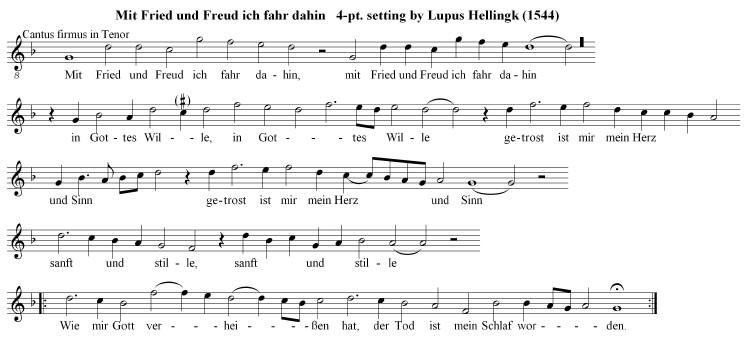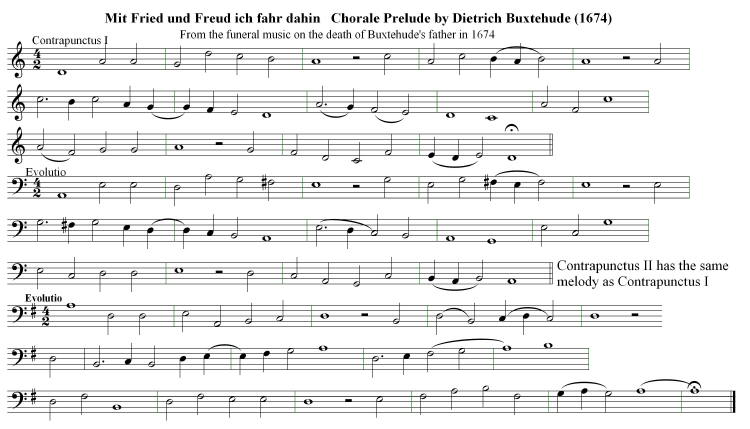|
Chorale Melodies used in Bach's Vocal Works
Mit Fried und Freud ich fahr dahin |
|
Melody & Text | Use of the CM by Bach | Use of the CM by other composers | Arragements/Transcriptions |
| |
|
Melody & Text: |
|
Composition: Zahn: 3986 | EKG: 310 |
|
Original Melody Source: |
|
The original melody by Martin Luther appeared together with his text in “Geystliche Gesangk Buchleyn” (published by Johann Walter), Wittenberg 1524 in a 4-pt.setting by Walther: |
|

|
| |
|
Other Chorale Melody Sources: |
|
A key source for Bach (one that he might have used) is the Gotha Hymnal from 1715 which shows the melody as follows: |
|

|
|
Other earlier sources worth examining for earlier stages that might be closer to the Martin Luther original are listed below under Use of the CM by other composers. |
| |
|
Text : Mit Fried und Freud | EKG: 310 |
|
Martin Luther based the text upon the ‘Nunc dimittis’ known in German as “Der Lobgesang Simeons” (“Simeon’s Song of Praise”) taken from Luke 2:27-32 (Luther Unrevised 1545 Bible) |
|
>> Und da die Eltern das Kind JEsus in den Tempel brachten, daß sie für ihn täten, wie man pfleget nach dem Gesetz, 28 da nahm er ihn auf seine Arme und lobete GOtt und sprach: 29 HErr, nun lässest du deinen Diener im Frieden fahren, wie du gesagt hast; 30 denn meine Augen haben deinen Heiland gesehen, 31 welchen du bereitet hast vor allen Völkern, 32 ein Licht, zu erleuchten die Heiden, und zum Preis deines Volks Israel.<<
|
|
[Luke 2:27-32 [NLT} |
|
>>So when Mary and Joseph came to present the baby Jesus to the Lord as the law required, 28 Simeon was there. He took the child in his arms and praised God, saying, 29 "Lord, now I can die in peace! As you promised me, 30 I have seen the Savior 31 you have given to all people. 32 He is a light to reveal God to the nations, and he is the glory of your people Israel!"<<
|
| |
|
Use of the Chorale Melody by Bach: |
|
Text : Mit Fried und Freud | EKG: 310
Author: Martin Luther (1545) |
|
Ver |
Work |
Mvt. |
Year |
Br |
RE |
KE |
Di |
BC |
Score |
Music Examples |
|
4 |
BWV 83 |
Mvt. 5 |
1724 |
324 |
250 |
325 |
- |
A167:5 |
PDF |
Mvt. 5 (MG) [midi] | Mvt. 5 (Leusink) [ram] |
|
1 |
BWV 95 |
Mvt. 1 |
1723 |
- |
- |
- |
- |
A136:1 |
- |
Mvt. 1 (Leusink) [ram] |
|
1 |
BWV 106 |
Mvt. 3b |
1707 |
- |
- |
- |
- |
B18:3b |
- |
Mvt. 3 (YFM) [midi] | Mvt. 3 (Leusink) [ram] |
|
1 |
BWV 125 |
Mvt. 1 |
1725 |
- |
- |
- |
- |
A168:1 |
- |
Mvt. 1 (Leusink) [ram] |
|
2 |
BWV 125 |
Mvt. 3 |
1725 |
- |
- |
- |
- |
A168:3 |
- |
Mvt. 3 (Leusink) [ram] |
|
4 |
BWV 125 |
Mvt. 6 |
1725 |
- |
251 |
- |
- |
A168:6 |
PDF |
Mvt. 6 (MG) [midi] | Mvt. 6 (Leusink) [ram] |
|

|
|

|
|

|
|

|
|

|
|

|
| |
|
Untexted: |
|
Ver |
Work |
Mvt. |
Year |
Br |
RE |
KE |
Di |
BC |
Score |
Music Examples |
|
- |
BWV 382 |
- |
? |
49 |
- |
- |
51 |
F144:1 |
PDF |
Chorale (MG) [midi] |
|
- |
BWV 616 |
- |
1713-15 |
- |
- |
- |
- |
K45 |
- |
|
|

|
|

|
| |
|
Use of the Chorale Melody by other composers: |
|
Lupus [Wulfaert] Hellinck (c1494-1541):
Mit Fried und Freud ich fahr dahin, 4-pt chorale setting (published 1544). |
|

|
|
Bartholomäus Gesius (1555/1562-1613):
Mit Fried und Freud ich fahr dahin a 4-pt. setting (1601). |
|

|
|
Michael Praetorius (1571-1621)
Mit Fried und Freud ich fahr dahin, 4-pt. chorale setting |
|
Johann Hermann Schein (1586-1630):
Mit Fried und Freud ich fahr dahin, SATB [bc] (1627)
Mit Fried und Freud ich fahr dahin, SS, bc (1618) |
|
Samuel Scheidt (1587-1654):
SSWV 302 Mit Fried und Freud ich fahr dahin (chorale, Luke ii.29–32), STB, bc;
SSWV 452 Mit Fried und Freud Tabulatur=Buch (1650). |
|

|
|
Dietrich Buxtehude (1637?-1707):
Mit Fried und Freud Cantata SB with 3 instr. or organ
Mit Fried und Freud ich fahr dahin chorale prelude for organ (1674). |
|

|
|
Buxtehude quote by Hermann Keller in the Peters Edition (volume 2) of Buxtehude’s organ works: |
|
>>These two chorale mvts., entitled by Buxtehude “Contrapunctus I and II,” are from the funeral music on the death of his father (1674) and are in quadruple counterpoint, i.e., the 4 voices can be mutually interchanged. In the “Evolutio” these possibilities are developed: in the 1st the soprano becomes bass, bass becomes soprano, alto tenor, and tenor alto; the whole is transposed into the dominant. The 2nd “Evolutio” brings (except for a few notes at the end) the mirror form; the voices are not only interchanged as in the first example but are also brought in inversion (compare Bach’s “Kunst der Fuge,” Contrapunctus XVI, XVII and XVIII.)<<
|
|
Georg Philipp Telemann (1681-1767):
Mit Fried und Freud ich fahr dahin (I), sacred cantata for chorus, 2 violins, viola, double-bass & continuo, TWV 1:1140 (~ 1729)
Mit Fried und Freud ich fahr dahin (II), sacred cantata for voice, violin & continuo (fragment), TWV deest |
|
Johann Gottfried Walther (1684-1748):
Mit Fried und Freud ich fahr dahin 4-pt. setting (1524). See: Score |
|
Johannes Brahms (1833-1897):
Motet Warum ist das Licht gegeben op.74 no.1 (1877) |
|
>>The motet Warum ist das Licht gegeben op.74 no.1 (1877), one of Brahms's finest a cappella works, draws extensively on material originally composed for the Missa canonica of 1856, set to an assemblage of biblical passages crafted by Brahms. Anxious homophonic queries (‘Warum?’) punctuating a densely chromatic fugal texture give way to imitative entries ascending in six parts, as humankind lifts its hands to God. A steadily progressing melody underlaid with imitative voices effectively conveys the patience of Job. The motet closes peacefully with a cantional setting of the Lutheran chorale Mit Fried und Freud.<<
George S. Bozarth and Walter Frisch in the Grove Music Online (Oxford University Press, 2005, acc. 9/23/05)
|
|
Max Reger (1873-1916):
Mit Fried und Freud fahr ich dahin, Chorale Prelude for Organ, Op. 79b/5 (1901-1903)
Chorale Prelude for organ (Mit Fried und Freud fahr ich dahin), Op. 79/10 (1901-1903) |
|
Ernst Pepping (1901-1981):
Partita no.3 Mit Fried und Freud, for organ (1953) |
| |
|
Arrangements/Transcriptions of Bach's use of the Chorale Melody: |
|
See list of Piano Transcriptions of BWV 616 by various composers/arrangers at:
Piano Transcriptions of Bach's Works - Index by BWV Number Part 4: Chorale Preludes for Organ |
| |
|
Sources: NBA, vols. III/2.1 & 2.2 in particular [Bärenreiter, 1954 to present] and the BWV ("Bach Werke Verzeichnis") [Breitkopf & Härtel, 1998]
The PDF files of the Chorales were contributed by Margaret Greentree J.S. Bach Chorales
Software: Capella 2004 Software, version 5.1.
Prepared by Thomas Braatz & Aryeh Oron (September 2005) |